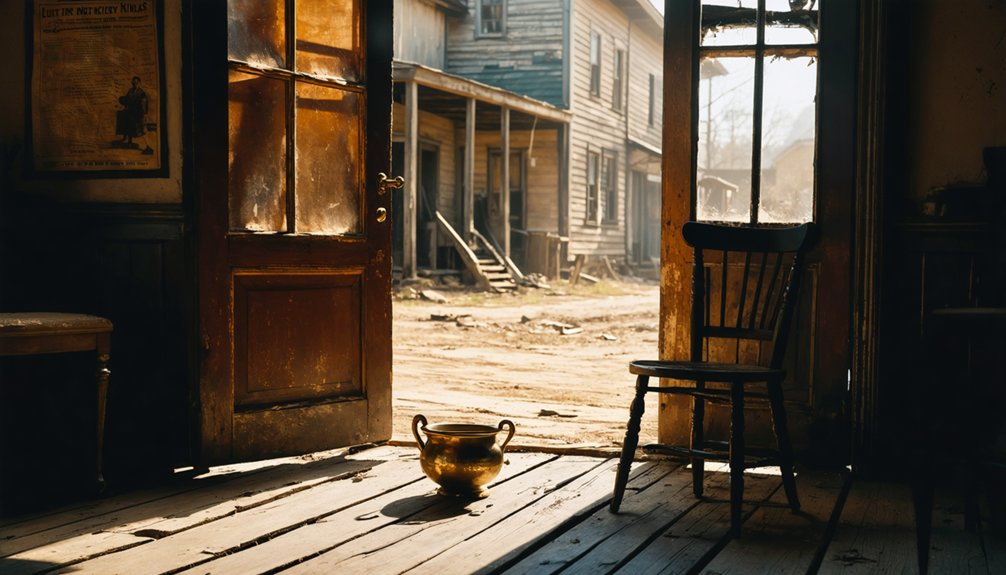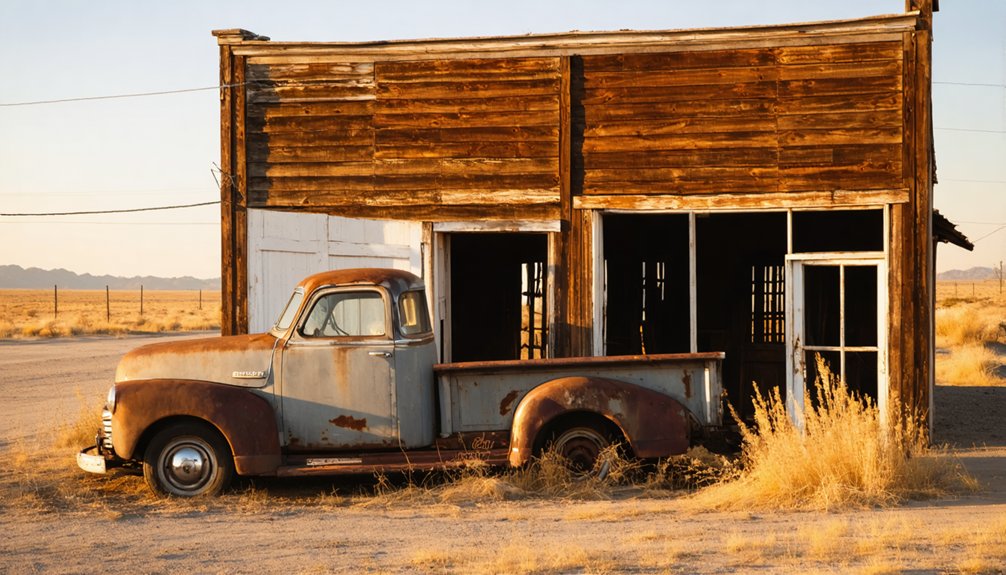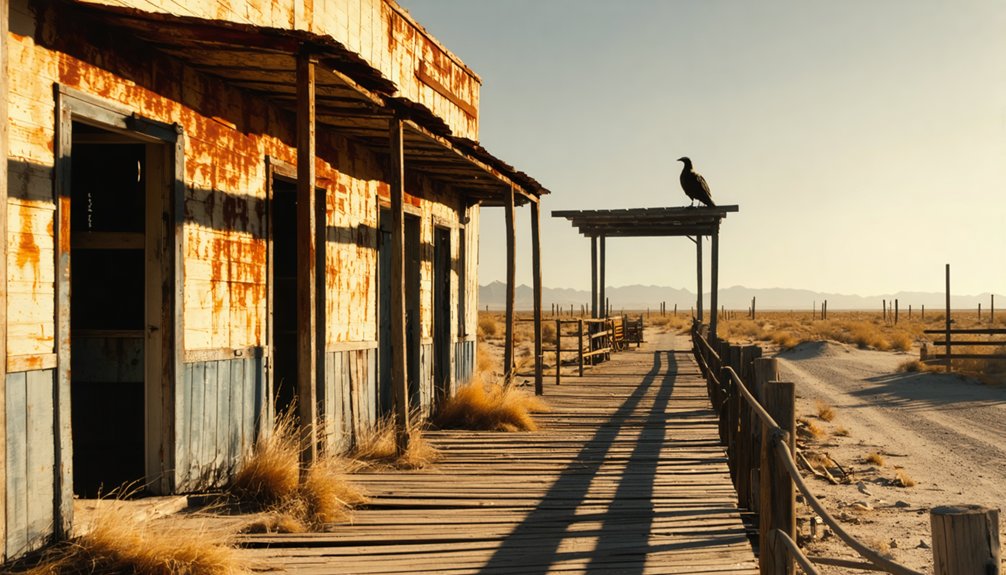Cuttens emerged during California’s 1850s Gold Rush, transforming from a collection of mining shacks into a thriving settlement. You’ll find its remains nestled in the Sierra Nevada foothills, where harsh climate and isolation challenged residents who worked grueling twelve-hour shifts. The town declined in the 1880s as mineral deposits dwindled and railway connections disappeared. Today, weathered structures and artifacts silently preserve the story of frontier ambition and struggle beneath the mountain’s watchful gaze.
Key Takeaways
- Cuttens emerged during the California Gold Rush in the 1850s, growing from mining shacks to thousands of residents until mineral depletion.
- Located in the Sierra Nevada foothills with harsh microclimates, Cuttens was isolated by mountain terrain and difficult road access.
- The town faced severe water challenges, relying on limited springs and seasonal creeks that contributed to its eventual abandonment.
- Daily life featured frontier accommodations, 12-hour mining shifts, and community activities in saloons and dance halls.
- Cuttens declined in the 1880s when mineral wealth diminished, leaving behind deteriorating structures that document its mining settlement history.
The Lost History of Cuttens: Unearthing a Forgotten Mining Settlement
While historians have documented many California Gold Rush settlements extensively, Cuttens remains one of the more enigmatic mining towns that emerged during the early 1850s.
Like countless camps dotting the Northern California landscape, Cuttens began as a transient collection of prospectors seeking fortune in placer deposits before evolving to more complex quartz mining operations.
You’ll find Cuttens’ legacy reflected in the tight mining claims—sometimes just 16-50 feet wide—that characterized the desperate rush for wealth. The introduction of water through ditches dramatically transformed mining operations and allowed previously unprofitable claims to yield substantial returns.
The settlement’s mining heritage evolved from individual prospectors working surface gold to industrialized operations requiring outside capital and technical expertise. Similar to other mining settlements, Cuttens likely saw the transition from simple panning to more advanced hydraulic mining techniques that became prevalent by 1853.
As surface gold depleted, Cuttens changed through the familiar pattern of boom-and-bust economics that defined so many settlements in the Tahoe National Forest region.
Geographic Location and Natural Surroundings
You’ll find Cuttens nestled within the dramatic terrain of the Sierra Nevada foothills, where rugged slopes and weathered outcroppings create a naturally fortified setting that contributed to the settlement’s isolation.
Its position at the fringe of Mojave Desert influences creates a harsh microclimate characterized by significant temperature fluctuations and sparse vegetation dominated by drought-resistant chaparral and scattered pine stands. Like many ghost towns in California, Cuttens emerged during the mid-1800s gold rush period when prospectors were drawn to the region’s mineral potential.
Several small seasonal springs and a now-diminished creek provided the settlement’s essential water supply, explaining both the original miners’ decision to establish Cuttens at this precise location and the subsequent operational challenges that plagued its development. The nearest established city is approximately one hour away via difficult mountain roads, similar to other preserved historical mining settlements.
Rugged Sierra Nevada Terrain
Towering majestically along California’s eastern border, the Sierra Nevada mountain range provides the dramatic backdrop for the ghost town of Cuttens. This formidable terrain stretches 400 miles north-south with impressive widths of 50-80 miles, creating natural barriers that once isolated settlements like Cuttens from civilization.
You’ll encounter an asymmetrical landscape—steep eastern escarpments contrast with more gradual western slopes. Rugged trails wind through granite formations that emerged from ancient volcanic activity and tectonic upheaval. The range boasts Mount Whitney, California’s highest peak at 14,494 feet, dominating the eastern skyline.
The range’s dramatic relief of up to 10,000 feet resulted from uplift along eastern fault zones merely two million years ago. Deep river canyons, some plunging 4,000-8,000 feet, carve through the mountains, further emphasizing the area’s inaccessibility. The region is often called the Range of Light due to its luminous qualities in changing daylight.
This complex topography of high ridges and intricate drainage patterns defined Cuttens’ isolation and ultimately contributed to its abandonment.
Mojave Desert Isolation
Unlike the Sierra Nevada’s dramatic peaks, the Mojave Desert presents a different kind of isolation for the ghost town of Cuttens.
Situated within the vast 47,877-square-mile arid expanse that stretches across California, Nevada, Utah, and Arizona, Cuttens embodies true desert solitude. You’ll find it near historical Route 66, surrounded by basin and range topography and sparse vegetation adapted to extreme aridity. The area’s barren landscape resembles the harsh conditions that once supported the production of calico fabric in the early trade routes. Much like the Route 66 ghost town of Amboy with its population of merely 20, Cuttens represents the fragility of desert settlements.
Access requires traversing dirt roads and secondary highways, with Barstow serving as the nearest urban outpost. The ghost town’s abandonment intensified as railroad routes changed and highways realigned.
Summer temperatures regularly exceed 100°F, while annual rainfall averages below 5 inches. This harsh environment, with its Joshua trees and creosote bushes, creates a challenging landscape that has preserved Cuttens’ isolation through decades of abandonment.
Water Sources Nearby
Despite its location in the arid Mojave Desert, Cuttens’ history was shaped by its precarious relationship with nearby water sources that proved insufficient to sustain long-term settlement.
You’ll find that the town relied primarily on limited springs and groundwater aquifers, which contrasted sharply with the abundant freshwater sources found in more hospitable regions of California. The town’s water struggles parallel the challenges faced by farmers in the San Joaquin Valley who often resort to deeper groundwater extraction when surface water becomes scarce.
These water features created isolated ecological habitats where desert wildlife concentrated, but ultimately couldn’t support expanding human populations. The geographic significance of Cutten as a failed settlement demonstrates how water availability determines community viability in arid regions.
- Natural springs in surrounding hills provided initial settlement water
- Seasonal creeks dried completely during summer months
- Groundwater extraction quickly depleted shallow desert aquifers
- No major rivers or reliable tributaries existed within viable distance
- Water quality deteriorated as aquifers lowered, introducing mineral contamination
Mining Operations and Economic Rise
After gold was discovered in the streams and gulches of the Cuttens area, the settlement experienced a transformation from scattered mining claims to a thriving economic center.
Mining techniques evolved rapidly from simple placer methods like panning and sluicing to more complex quartz vein extraction requiring underground shafts and dewatering systems. You’d have witnessed technological advancements including air drills and mechanized equipment that increased productivity.
The region’s economic fluctuations mirrored the volatile nature of mining towns. Following the financial depression of 1886-7, Cuttens provided temporary relief to Southern California’s economy.
The late 1870s rush dramatically expanded the population from a few shacks to thousands of residents. A diverse workforce of Americans, Mexicans, Chinese, and Europeans contributed their skills to the operations, creating a multicultural boomtown that flourished until deposits were eventually exhausted.
Daily Life in a California Boom Town

If you’d lived in Cuttens during its boom period, you’d have experienced the stark contrasts of frontier accommodations, from hastily constructed wooden shacks to more substantial boarding houses that offered minimal comforts after grueling twelve-hour mining shifts.
Your workday might’ve begun before dawn and ended after dusk, following the rhythms of extraction and processing that defined the town’s economic pulse.
During precious leisure hours, you could have sought respite in the town’s round-the-clock saloons, attended community dances that united the diverse population, or participated in outdoor recreational activities that provided temporary escape from the industrial landscape.
Rough Frontier Housing
Housing in Cuttens exemplified the makeshift frontier architecture common to California boom towns of the era, where necessity trumped comfort and expediency overruled craftsmanship.
You’d find temporary structures ranging from dugouts to single-room cabins, hastily assembled as miners flooded the Owens Valley. Communal living defined the social landscape, with bunkhouses accommodating single workers and boarding houses providing meager amenities for those willing to share quarters.
- No running water meant hauling every drop from wells or springs
- Wood stoves provided your only heat source amid harsh mountain winters
- Dirt floors were common, inviting drafts and unwelcome wildlife visitors
- Outhouses served hundreds, situated away from main buildings
- Personal space was virtually nonexistent, with entire families sharing single rooms
Mining Work Routines
While candles flickered in the pre-dawn darkness, miners in Cuttens began their grueling sixteen-hour shifts that defined life in this California boom town.
You’d descend into narrow drifts supported by timber frames, your pick and drill attacking the rock face in search of ore yielding at least $25 per ton—the threshold for profitability.
Mining techniques varied, but success always depended on skilled identification of valuable deposits amid worthless rock.
You’d load promising ore into small rail cars while pumps labored to keep lower levels dry.
When your shift ended, another crew would take your place, ensuring continuous ore extraction.
The cacophony of stamp mills formed Cuttens’ industrial heartbeat as diverse laborers—Chinese, European, and American—worked side by side in the pursuit of fortune, enduring dust, danger, and darkness for the promise of freedom through prosperity.
Social Entertainment Options
After enduring backbreaking labor in the mines, Cuttens residents enthusiastically sought respite in the town’s vibrant social landscape where entertainment options offered temporary escape from the harsh realities of frontier life.
The saloon emerged as the epicenter of community engagement, functioning not merely as a drinking establishment but as a multifaceted social institution where you’d exchange news, forge alliances, and participate in entertainment venues of various kinds.
- Dance halls attached to saloons hosted weekly events where miners could socialize across class boundaries
- Card games and gambling activities provided both recreation and potential financial opportunity
- Impromptu musical performances featured local talent playing popular frontier melodies
- Storytelling circles formed organically, preserving regional folklore and mining lore
- Community celebrations marked holidays and mining successes through shared social gatherings
The Decline and Abandonment of Cuttens

The decline of Cuttens followed a predictable pattern common to California mining settlements once their mineral wealth began to wane in the early 1880s.
Despite brief mini-booms that sparked temporary community resilience, the exhaustion of profitable minerals triggered an irreversible economic transformation. Mining companies relocated, taking workers and their purchasing power.
You’d have witnessed a rapid population exodus as Cuttens’ businesses shuttered one by one.
The railway—once essential for transporting ore and supplies—was eventually abandoned, severing the town’s lifeline to outside markets.
Buildings deteriorated without maintenance, accelerated by fires and harsh weather conditions.
Visiting the Remnants: What Survives Today
Today’s visitors to Cuttens encounter a haunting tableau of architectural persistence amid natural reclamation, where surviving structures stand as silent sentinels to California’s boom-and-bust mining legacy.
You’ll navigate unpaved roads requiring high-clearance vehicles to discover this unfiltered slice of history, where no official preservation efforts exist.
- The wooden general store and several cabins remain upright, defying time’s erosion.
- Native flora gradually reclaims the landscape, with trees growing through collapsed roofs.
- Rusting mining equipment and household artifacts pepper the site, telling stories of former inhabitants.
- Wildlife has established residence in abandoned structures, creating a curious ecosystem.
- The town’s water tank and post office fragments offer tangible connections to daily life in this once-thriving community.
Frequently Asked Questions
Were Any Famous Outlaws or Celebrities Associated With Cuttens?
You’ll find no documented famous outlaw legends or celebrity sightings connected to Cuttens. Historical records lack evidence linking notable figures to this particular California ghost town, unlike more prominent settlements like Bodie.
What Happened to Cuttens’ Residents After Abandonment?
After abandonment, you’d find Cuttens’ migration patterns led residents to nearby towns, western mining regions, or cities. Their social dynamics fractured as families dispersed, though some maintained cultural connections through preservation networks.
Are There Any Documented Paranormal Activities in Cuttens?
Unlike notable haunted locations in California, you’ll find no documented ghost sightings or paranormal activities in Cuttens. Research reveals an absence of credible reports, investigations, or historical accounts of supernatural phenomena there.
Was Cuttens Connected to Any Major Historical Events?
No, Cuttens wasn’t connected to major historical events. You’ll find its history and historical significance remain minimal within California’s narrative, overshadowed by more prominent mining settlements in the region.
Are There Any Surviving Photographs of Cuttens During Its Heyday?
While 70% of California ghost towns have photographic records, Cuttens lacks confirmed imagery. Your archival research might uncover private collections or county historical societies where historic preservation efforts preserved such documentation.
References
- https://www.pbssocal.org/shows/lost-la/bodie-the-ghostliest-of-ghost-towns
- https://www.nps.gov/deva/learn/historyculture/death-valley-ghost-towns.htm
- https://en.wikipedia.org/wiki/List_of_ghost_towns_in_California
- https://wandering-through-time-and-place.com/tag/californias-highway-395/
- https://www.loveproperty.com/gallerylist/95716/the-man-who-spent-lockdown-in-his-own-private-ghost-town
- https://www.youtube.com/watch?v=P_Xqz0HvLlo
- https://nvtami.com/2020/08/12/bodie-photo-essay/
- https://discardstudies.com/2013/09/30/arrested-decay-the-exorcism-of-an-american-ghost-town/
- https://nevadacityhistory.com/history/sargent-sketch-of-nevada-county.php
- https://en.wikipedia.org/wiki/California_gold_rush



